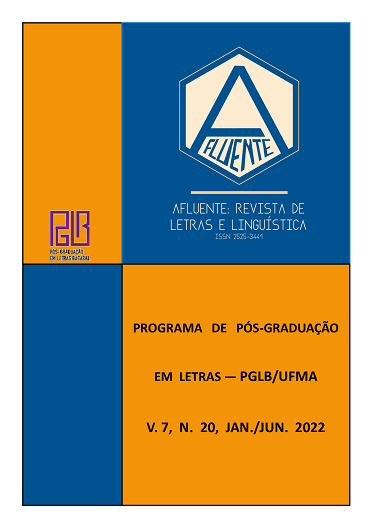THE TALE AS FORM OF TWO NARRATIVES IN THE TORTURAS DE AMOR COLLECTION
DOI:
https://doi.org/10.18764/2525-3441v7n20.2022.10Keywords:
Implicit narrative, Torturas de amor, Genre short storyAbstract
To encounter the tales present in Torturas de amor, collection of texts written by northeastern writers, based on the Brega musical genre and organized by Bruno Gaudêncio, is to find several lyrical universes, with different representations of love. The narratives taken here, namely, “It is impossible to believe that I lost you”, by Roberto Menezes and “I break this
table today”, by Bráulio Tavares, however, they are not analyzed, at least as a priority, in the light of this fruitful thematic field that is love. Reading such narratives, as attractive as they are due to the cathartic content, also allows contact with the short story, considering the text as a process and as a structure, without, of course, disregarding the content, understanding them in an articulated way (cf. EAGLETON, 2011, p. 46). Thus, one of the possibilities of approaching the formal configuration of the story is that proposed by Piglia (2004), about the fact that, in the story, two narratives coexist, one explicit and the other more implicit, but both of great value for understanding of the genre. The stories discussed here present, based on their proposals, the structure defended by Piglia (2004). Thus, the objective of this study is to analyze the two narratives pointed out by the theorist quoted in two short stories from the collection Torturas de amor, which reached the editorial market in 2019 to add to the vast contemporary production of short stories. Hence the importance of being taken as an object of literary studies.
Downloads
References
BAKHTIN, Mikhail. Teoria do Romance II: As formas do tempo e do cronotopo. 1. Ed. São Paulo: Editora 34, 2018.
BENJAMIN, Walter. O narrador: considerações sobre a obra de Nikolai Leskov. Magia etécnica, arte e política: ensaios sobre literatura e história da cultura. São Paulo: Brasiliense,
, p. 197-221.
CORTÁZAR, Julio. “Alguns aspectos do conto”. In Valise de cronópio. Trad. Davi Arrigucci Jr. e João Alexandre Barbosa. São Paulo: Perspectiva, 1974.
DELEUZE, Gilles e GUATTARI, Félix. Mil platôs - capitalismo e esquizofrenia. Rio de Janeiro: Ed. 34, 1995.
EAGLETON, Terry. Marxismo e crítica literária. São Paulo: Editora Unesp, 2011.
GAUDÊNCIO, Bruno. Torturas de amor. Guaratinguetá, SP: Penalux, 2019.
LUCIANO, Aderaldo. Trilha sonora, escrita e cantada. In. Torturas de amor. Guaratinguetá, SP: Penalux, 2019.
PIGLIA, Ricardo. Formas Breves. Trad. José Marcos Mariani de Macedo. São Paulo: Companhia das Letras, 2004.
REIS, Carlos & LOPES, Ana Cristina. Dicionário de Teoria da Narrativa. São Paulo: Ática, 1988.
VELÔZO, Paula. O Brega, os Meios e as Novas Tecnologias: Relações de Poder e Representação nos Meios Audiovisuais. In. XXXIV Congresso Brasileiro de Ciências da Comunicação. Recife, 2011.
Downloads
Published
How to Cite
Issue
Section
License
Copyright (c) 2022 Afluente: Revista de Letras e Linguística

This work is licensed under a Creative Commons Attribution 4.0 International License.
Direitos autorais Afluente: Revista Eletrônica de Letras e Linguística
Este trabalho está licenciado com uma Licença Creative Commons - Atribuição 4.0 Internacional.















